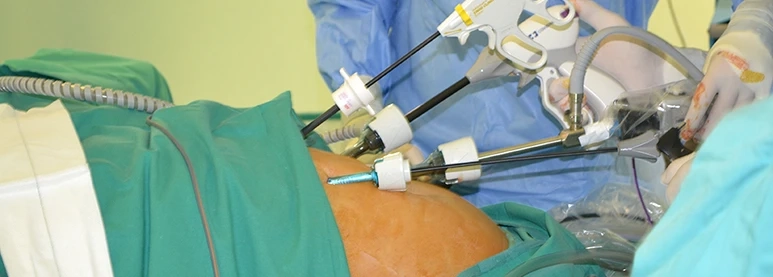Laparoscopy is the minimally invasive alternative to conventional open surgery that uses a small camera called a laparoscope to see inside the abdomen. It is considered the major surgical breakthrough of the 20th century. It is performed through small openings in the abdominal cavity that are between 0.5 and 1.5 mm in size. Through a minimal incision in a longitudinal fold of the umbilicus, the endoscope can be inserted with a micro camera attached to it, which provides a panoramic view of the organs of the abdominal cavity on a monitor. In this way, the laparoscope transmits the image of the internal organs to a monitor through which the surgeon can be guided to perform various surgical procedures. The laparoscope magnifies the image many times its actual size, allowing a better view of the abdominal organs. Originally, this technique was used for gynecological and gallbladder surgeries. Today, almost any abdominal procedure can be performed laparoscopically, provided the surgical team is sufficiently trained and experienced.
Instruments used A number of instruments are needed to perform a laparoscopic procedure
Laparoscopy tower. Laparoscopy tower consists of a monitor on which, thanks to the camera, we can see the area where the operation is to be performed. And a set of devices responsible for controlling the introduction of the pneumoperitoneum and the quality of the image.
The laparoscope. The laparoscope, also known as an optic, is the camera that we insert into the abdomen to visualize the area to be operated on. It is an integrated camera with light that allows a complete 360º rotation.
Trocars. These are the instruments with which we can penetrate the abdominal wall thanks to their punching. They are made of plastic and come in different sizes depending on the instrument we need. The punch is inserted into the torso; it is atraumatic, that is, it does not cut, but separates the tissue to cross the area.
Other instruments. These are tweezers, forceps, etc. They must be larger than 30 cm and have a thread that allows us to move them to follow different movements of the instruments.
Straight Engraver (Endogia). It is a very useful instrument used in multiple procedures for simultaneous cutting and clamping. It offers lateral and 360º movement and can be easily operated with only one hand. It is inserted into the abdominal wall with a 12-mm stub.
Device for the placement of clicks. It is also inserted through a 10mm punch.
How is the laparoscopic procedure performed?
After the patient is anesthetized and completely asleep, the trocar is first inserted through the abdominal wall to insert the optic or laparoscope. At this time, the monitor shows the abdominal cavity and the remaining [caption class="snax-figure" align="aligncenter" width="1140"][/caption]instruments that will be needed later.
New 11-mm trocars are inserted and then the pneumoperitoneum cable is placed. Using the optics, we select the area where the remaining trocars will be inserted. The size of the trocars depends on the instruments used in each situation.
Keeping the pneumoperitoneum wedge, we insert an endocast pouch through which the specimen is taken through the umbilical area if necessary (such as in gallbladder surgery).
In a laparoscopic procedure, surgeons gain access to the abdomen through small incisions (¼ to ½ inch or 6 to 12 mm) using cannulas (narrow tubular instruments). The laparoscope, which is attached to a tiny video camera, is inserted through the small cannula. An image is projected onto a monitor, which provides the surgeon with a magnified image of the stomach and other internal organs. Special instruments are inserted through five to six small incisions and cannulas to perform the surgery.
Ideal candidate
Despite the advantages offered by this technique, not all patients are candidates for laparoscopic surgery. Each person has unique circumstances and must be considered individually by the specialist.
For people with severe chronic obstructive pulmonary disease or previous unsatisfactory surgery, laparoscopic surgery may be difficult or even contraindicated.
Why laparoscopic surgery: advantages
Better recovery after surgery
Lower rate of short- and long-term complications.
The patient suffers less pain
Better physical appearance due to better healing and smaller size.
The field of surgery has evolved greatly over time thanks to technological advances, and laparoscopy is an example of this. Thanks to this technique, we can perform procedures that reach into the abdominal cavity without the need for open surgery.


